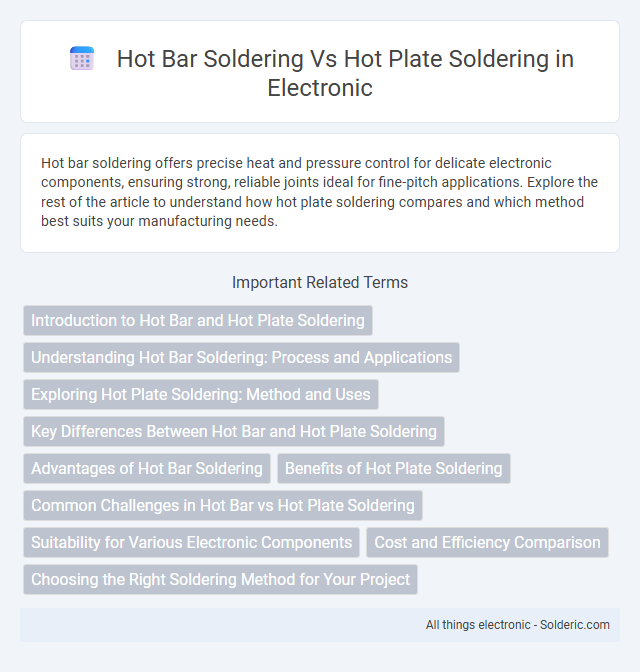Hot bar soldering offers precise heat and pressure control for delicate electronic components, ensuring strong, reliable joints ideal for fine-pitch applications. Explore the rest of the article to understand how hot plate soldering compares and which method best suits your manufacturing needs.
Comparison Table
| Feature | Hot Bar Soldering | Hot Plate Soldering |
|---|---|---|
| Heating Method | Heated indenter directly applies pressure and heat | Flat heated plate provides uniform heat without pressure |
| Application | Used for wire bonding, chip attachment, and flexible circuit soldering | Ideal for reflow soldering of PCB assemblies and surface mount components |
| Temperature Control | Precise localized temperature control | Uniform temperature across the plate surface |
| Pressure Application | Pressure applied via heated bar | No pressure applied |
| Process Speed | Faster bonding due to combined heat and pressure | Slower heat transfer, longer soldering times |
| Material Compatibility | Works well with delicate and flexible materials | Best for rigid PCBs and components |
| Equipment Cost | Generally higher initial cost | Lower initial investment |
| Maintenance | Requires regular calibration and bar replacement | Minimal maintenance needed |
Introduction to Hot Bar and Hot Plate Soldering
Hot bar soldering uses a heated tool to apply pressure and heat simultaneously for precise, localized bonding of electronic components, ideal for flexible circuits and small assemblies. Hot plate soldering involves placing the entire assembly on a heated surface to uniformly heat components, suitable for larger PCBs or batch processing. Your choice depends on the complexity and scale of the soldering task, with hot bar offering targeted heat application and hot plate providing consistent overall temperature.
Understanding Hot Bar Soldering: Process and Applications
Hot bar soldering utilizes a heated tool to apply pressure and heat simultaneously, bonding components with precision in electronics assembly and flexible circuits. This process ensures consistent solder joints by controlling time, temperature, and pressure parameters, making it ideal for delicate or miniaturized components. Your manufacturing can benefit from hot bar soldering's repeatability and applicability in processes like screen-to-flex and flex-to-board bonding.
Exploring Hot Plate Soldering: Method and Uses
Hot plate soldering involves heating a flat metal plate to a controlled temperature, allowing soldering by placing components and circuit boards directly on the heated surface. This method provides uniform heat distribution, making it suitable for reflow soldering of surface mount technology (SMT) components and small batch production. It is commonly used for prototype development, repair, and applications requiring precise temperature control without the need for flux or complex equipment.
Key Differences Between Hot Bar and Hot Plate Soldering
Hot bar soldering uses a heated welding bar to apply pressure and heat simultaneously, enabling precise bonding of flexible circuits and components, while hot plate soldering involves placing components on a heated surface for uniform heat distribution without pressure. Hot bar soldering provides controlled force and temperature for delicate assemblies, making it ideal for applications requiring accuracy and repeatability. Your choice depends on the specific soldering needs, with hot bar offering targeted pressure and heat, whereas hot plate delivers consistent thermal exposure over larger areas.
Advantages of Hot Bar Soldering
Hot bar soldering offers precise heat and pressure control, enabling reliable and repeatable connections, particularly in delicate electronic assemblies like flex circuits and displays. Its localized heating minimizes thermal damage to sensitive components compared to hot plate soldering, which heats the entire assembly. This method also enhances join quality and reduces cycle times, making it ideal for high-volume, automated manufacturing processes.
Benefits of Hot Plate Soldering
Hot plate soldering offers precise temperature control, reducing the risk of thermal damage to sensitive components during the assembly process. This method enables uniform heat distribution across the entire board, enhancing solder joint consistency and reliability compared to localized heating techniques like hot bar soldering. Its compatibility with various PCB sizes and designs makes hot plate soldering a versatile choice in electronics manufacturing for improving overall assembly quality.
Common Challenges in Hot Bar vs Hot Plate Soldering
Hot bar soldering often struggles with precise temperature control, leading to inconsistent joint quality compared to hot plate soldering, which benefits from uniform heat distribution across the work surface. Hot plate soldering faces challenges with longer heating times and potential thermal damage to sensitive components, whereas hot bar soldering can cause uneven pressure application affecting solder joint reliability. Both methods require careful process optimization to mitigate issues like solder bridging, insufficient wetting, and thermal stress during assembly.
Suitability for Various Electronic Components
Hot bar soldering is highly suitable for precision electronic components such as flexible circuits, LED arrays, and small connectors due to its controlled heat application and pressure, ensuring strong, reliable joints without damage. Hot plate soldering excels in processing larger or multiple components simultaneously, providing uniform heat distribution ideal for components like printed circuit boards (PCBs) and connectors with broader contact areas. Selecting the appropriate method depends on component size, thermal sensitivity, and production volume requirements.
Cost and Efficiency Comparison
Hot bar soldering typically incurs higher initial equipment costs but offers superior cycle times and precision for complex assemblies, enhancing overall efficiency in high-volume production. Hot plate soldering presents a lower upfront investment with simpler operation but tends to involve longer heating cycles and less consistent joint quality, impacting throughput. Manufacturers must balance budget constraints with desired production speed and solder joint reliability when choosing between these methods.
Choosing the Right Soldering Method for Your Project
Hot bar soldering offers precise, localized heat ideal for delicate components, while hot plate soldering provides uniform temperature distribution suited for larger assemblies. Selecting the right soldering method depends on factors such as component size, thermal sensitivity, and production volume. For your project, consider the specific heat control and efficiency requirements to ensure optimal solder joint quality.
Hot bar soldering vs hot plate soldering Infographic

 solderic.com
solderic.com